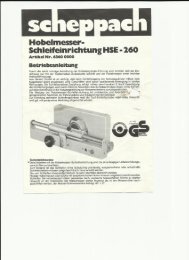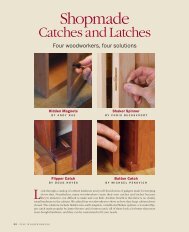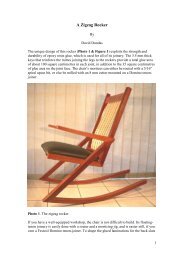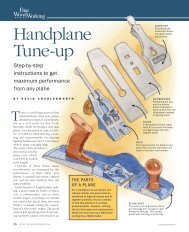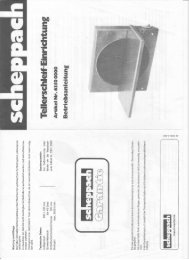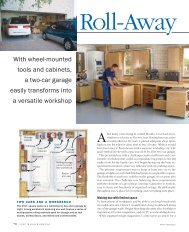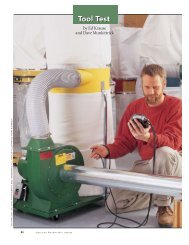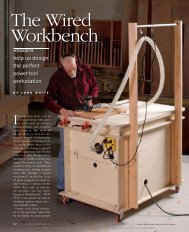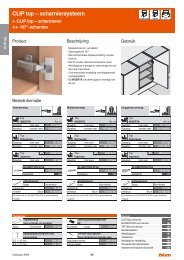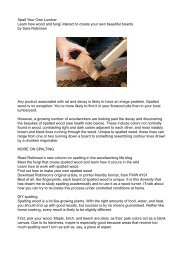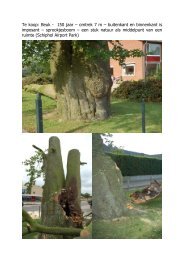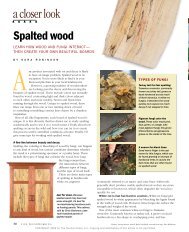DustCollector
DustCollector
DustCollector
You also want an ePaper? Increase the reach of your titles
YUMPU automatically turns print PDFs into web optimized ePapers that Google loves.
To avoid sharp turns, a pair of adjustable<br />
elbows connects the vacuum on the<br />
cyclone to the frlter box.<br />
There's more to getting the Dust<br />
Collector working than just setting up<br />
lengths of pipe. You still need a way to<br />
hook up individual tools to the system.<br />
Although there are a number of manufactured<br />
hookups available, their cost<br />
can add up quickly (especially if you're<br />
connecting three or four tools). So I<br />
decided it would be just as easy to<br />
make my own.<br />
Basically, I needed two types of<br />
hookups: blast gates and dust hoods.<br />
The blast gates turn the flow of air on<br />
and off at each tool. This makes the<br />
system more efficient, by preventing<br />
the vacuum from pulling air from more<br />
than one tool. And the dusthoods direct<br />
chips and dust into the system. (Several<br />
styles of tool and dust collection hookups<br />
are shown on the following pages.)<br />
BLAST GATES. To control the flow of<br />
air in the system so there's only one tool<br />
online at a time, I added a blast gate at<br />
each tool (see photo at right). This way,<br />
I can easily turn the suction on (or offl<br />
at a tool simply by opening (or closing)<br />
the blast gate.<br />
Basically, each blast gate is just a<br />
short section of 4rr-diameter duct pipe<br />
with a slot cut in it. This slot creates an<br />
opening for the blast gate, allowing<br />
you to slide a piece of sheet metal in<br />
and out (Fig.25).<br />
DlsKs. To support the walls of the<br />
pipe when cutting the slot, I cut two plywood<br />
disks to size to fit inside the ends<br />
(Fig. 26). Then just tighten the pipe<br />
(and the disks) in a vise and cut the slot<br />
halfway through.<br />
GATE. After removing the pll'rvood<br />
disks, the gate can be cut to fit in the<br />
slot. The gate is just a strip of sheet<br />
metal that's cut to the same width as the<br />
diameter of the pipe (Fig.25).<br />
To keep air from leaking through<br />
when the blast gate is closed, the end<br />
needs to fit tight against the curved<br />
inside wall of the pipe. To do this, scribe<br />
the shape of the pipe on the metal and<br />
trim the end to fit (Fig. 2'i).<br />
Note: I used a pair of tin snips to trim<br />
the gate, then I used a file to knock<br />
down any rough edges left over from<br />
cutting the sheet metal. The idea is to<br />
make sure the gate slides in and out<br />
smoothly without catching.<br />
HANDIE. Next, I sandwiched the<br />
square end of the sheet metal gate<br />
between two blocks of hardwood and<br />
tacked them together to serve as a<br />
handle (Fig.2it). Also, to keep the gate<br />
from falling out when it's opened, I<br />
drilled a hole and installed a small<br />
sheet-metal screw near the curved end<br />
of the gate (Fig. !,1).<br />
CRIMP ENDS. Finally, I crimped both<br />
ends of the blast gate pipe (using the<br />
Sliding a shop-made blast gate in and<br />
out of a pipe turns the suction off<br />
(or on) at each tool.<br />
sffi@p YKp<br />
tharp Corners<br />
To create a sharp corner<br />
where needed on the sheet<br />
metal, bend the metal over<br />
the edge of your saw table<br />
with a dead-blow mallet.<br />
shop-built crimping tool described on<br />
page 121) and installed it behveen the<br />
metal pipe and the flex hose leading to<br />
each tool hooked to the system.<br />
=<br />
=<br />
=<br />
I_<br />
!r-<br />
Il-<br />
I-<br />
F_<br />
I-<br />
G-<br />
-<br />
rr-<br />
tr-<br />
=<br />
I-<br />
Ê<br />
E<br />
=<br />
F-<br />
--<br />
F-<br />
=<br />
=<br />
E<br />
or".l,ooo I<br />
ll '/<br />
sïËËóií I ll ./.-YSJE' CUT 4" x UYr'rr^t O, /<br />
SHEET METAL FOR BLAST GATE<br />
=<br />
=<br />
=<br />
=<br />
I-<br />
=<br />
t-<br />
122 :i,&,ii{ f} ï f{ & li, li! {.} q'i' ill., rl.} l,l 1 f.! {l,rr,-<br />
I-



